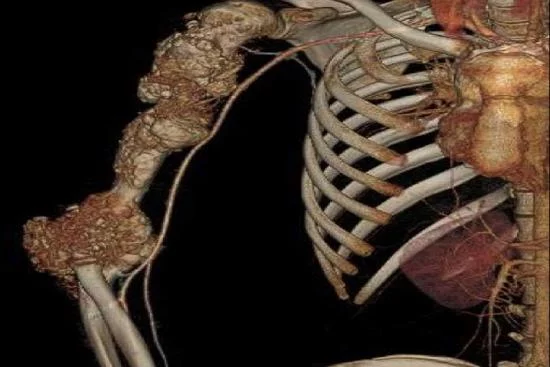Bone cancer is an abnormal growth of cells in bone that can destroy normal bone tissue. Although relatively rare, it can cause significant discomfort and interfere with daily activities for those affected. However, studies on bone cancerin Turkey, has made remarkable strides, offering hope and improved outcomes for patients.
We're Here to Help.

Benign & malignant bone tumors
Benign bone cancers refer to non-cancerous tumors that arise within the bone. These tumors remain localized and do not infiltrate surrounding tissues or metastasize. Although benign tumors may not be as alarming as malignant ones, they can still cause discomfort and may require treatment.
Malignant bone tumors, unlike their benign counterparts, are cancerous and have the potential to spread to other parts of the body. These tumors arise from abnormal cells that invade the bone and can disrupt its normal structure and function.
Types of primary bone cancer
Cancers that start in the bones are called primary bone cancers. They occur mainly in the upper and lower limbs, but can occur in any bone in the body. Children and teenagers are more likely to get bone cancer than adults.
Primary bone cancers are called sarcomas. There are different types of sarcomas. Each occurs in a different type of bone tissue. The most common are osteosarcoma, Ewing's sarcoma, and chondrosarcoma.
- Osteosarcoma starts in bone cells and is most common in the knee and upper extremity. It is most common in adolescents and young adults. There is a form of this tumor that is often seen in people with pre-existing Paget's disease.
- Ewing's sarcoma is seen in young people between the ages of 5 and 20. The pelvis, leg, and upper arm are the most common sites. It usually starts in the bone, but can also start in the soft tissues around the bone.
- Chondrosarcoma primarily affects people between the ages of 40 and 70. This type of cancer, which originates from cartilage cells, often occurs in areas such as the pelvis, hips, legs, arms, and shoulders.
Types of benign bone tumors
There are several common types of benign bone cancers, including:
- Osteochondroma: This is the most common benign bone tumor. It typically occurs near the growth plates in the long bones, often in the knee.
- Simple bone cyst: These fluid-filled cysts are also known as unicameral bone cysts. They most commonly affect children and adolescents.
- Giant cell tumor: An uncommon, aggressive benign tumor. It typically manifests in adults aged 20 to 40, after the completion of skeletal bone growth.
- Fibrous dysplasia: A condition in which normal bone is replaced by fibrous tissue, resulting in weakened bones.
- Chondroblastoma: A relatively rare benign bone tumor that develops from cells called chondroblasts, which are involved in cartilage formation.
- Aneurysmal Bone Cyst: This is a non-cancerous bone lesion that often occurs in the long bones of young people.
- Osteoid osteoma: A small, benign tumor that usually causes pain and occurs in the long bones of the body.
How to recognize the symptoms of the cancer?
The symptoms of bone cancer may vary depending on the location and type of cancer. However, there are some common signs to look out for, including:
- Persistent bone pain
- Swelling or a lump
- Limited range of motion
- Fatigue
- Unexplained weight loss
If you experience any of these symptoms, it is crucial to seek medical attention promptly. A thorough evaluation will involve a combination of imaging tests, such as X-rays, CT scans, and MRI scans, to visualize the affected area. Biopsy, where a sample of the bone tissue is taken for further examination, is often required to confirm the diagnosis and determine the type and stage of cancer.
What causes Osteogenic Sarcoma?
The exact origin of bone cancer is unknown. However, many factors can induce a risk of the growth of bone cancer cells:
- Geneticfactors: Some rare genetic factors inherited through families raise the probability of osteosarcoma, like Li-Fraumeni syndrome and retinoblastoma.
- Paget'sdisease: an abnormality in bone metabolism, often without noticeable symptoms, especially in older individuals. It can increase the risk of osteosarcoma, osteoarthritis, fractures, nerve compression, and in rare cases, hypercalcemia.
- People who have undergone radiotherapy to treat other types of cancer have an increased risk of developing osteosarcoma. Exposure to radiation at a young age increases the risk.
Bone cancer treatment in the best clinics in Turkey
Bone cancer treatment requires a team of specialists. Collaboration between the oncologist, radiologist, surgeon, and orthopedist is essential for the best possible outcome for the patient.
The goal of treatment is to cure the cancer, maintain physical function, avoid amputations, and maintain a good quality of life for the patient.
Treatment is different for localized tumors. In cases where it has metastasized, treatment is more difficult.
The therapeutic armamentarium consists mainly of the following methods:
Surgical treatment
The main goal of surgery is to remove the tumor and all cancer cells. This operation is best performed by surgeons who specialize in this field.
Today, amputations can be avoided in most cases. The conservative approach is combined with metal or biological bone prostheses.
About Chemotherapy
Chemotherapy is used to kill cancer cells in the primary tumor or other parts of the body.
Chemotherapy is often given before surgery to reduce the size of the tumor and to fight cancer cells that have spread to other parts of the body. Chemotherapy given before surgery may be continued after surgery.
Radiation therapy
Radiationtherapy is used for tumors that are sensitive to high doses of radiation.
In certain difficult, resistant, relapsed, or metastatic cases, other therapeutic approaches may be used, such as autologous transplantation of pluripotent hematopoietic cells after high doses of chemotherapy, or targeted therapies with antibodies or specific agents that neutralize the proteins produced by the mutated genes.
Once treatment for a bone tumor is completed, regular follow-up is necessary. Because of the risk of disease recurrence, it is important to detect tumor recurrence at an early stage, either at the primary site or elsewhere in the body.
Recovery from cancer in Istanbul, Turkey
Ideally, multidisciplinary bone tumor treatment should take place at referralclinics in Turkey that have all the experience and resources needed to treat this type of tumor.
With Turquie Santé, you will benefit from the best care plans to cure your disease, regardless of its stage. Don't hesitate to send your medical file to our partner clinics in Istanbul, Izmir, or Antalya. We guarantee you the best services and care at the best costs.
Seriousness and professionalism are our core values: with Turquie Santé, we are committed to providing you with maximum support and the best medical care.
Share this page
Among our doctors
We are partnered with the best hospital for bone cancer in Turkey that offers the latest treatment options with the highest success rates.
Indeed, it is the most recognized oncology center in Turkey that has the most reputed oncology doctors in the world.
The most common treatment options for bone cancer in our clinics in Turkey include:
- Surgeries: amputation or limb-sparing surgery;
- Chemotherapy and radiattion therapy: to reduce the size of the tumour;
- Complementary medication treatments.
Bone cancer symptoms and signs include:
- Swelling of the limb where the bone tumor has grown;
- Bone fractures;
- Difficulty moving the limb affected by cancer.
The bone cancer's treatment in our clinics in Turkey doesn't necessarily require limb amputation. The amputation of the limb affected by cancer is only inevitable when the bone tumour affects the nerves, essential blood vessels, and tissues surrounding the affected bone.
Yes, there are several surgical methods that can treat bone cancer by sparing the limb in our oncology clinics in Turkey, such as:
- Monoblock resection;
- Curettage;
- Cryosurgery;
- Conservative surgery (limb-sparing surgery).
For patients diagnosed with bone cancer, the 5-year net survival rate is estimated at 65%. Several factors can influence this percentage, such as age, and stage of the osteosarcoma (1, 2, 3, or 4).
Regardless of the type of cancer, the principal element that feeds the tumor is sugar. Glucose feeds the cancer cells and promotes their development, which leads to metastasis.









